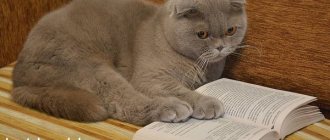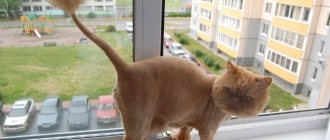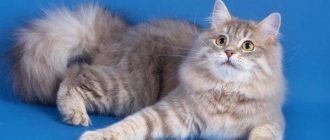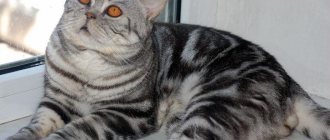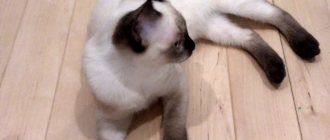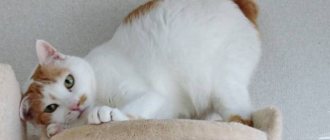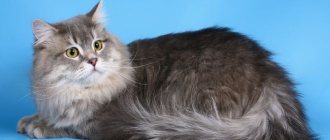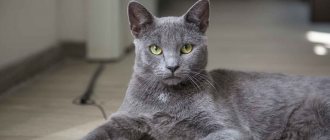Good afternoon, our dear readers! We, the Valitov brothers, are always happy to welcome you to the pages of our blog to discuss various situations together.
Today we’ll talk about a disease that tends to bring pain and suffering to our smaller brothers - it’s weeping eczema in cats.
This inflammatory pathology of the surface layer of the skin in cats often manifests itself as an acute form of the disease, accompanied by itching and weeping discharge.
The disease is considered difficult to cure. It is most difficult for long-haired breeds of animals aged from one to two years.
What types of weeping eczema develop in cats, what are their symptoms, causes of appearance and stages of development? How the owner should treat his tailed pet, for which he is responsible, we’ll talk about this a little later.
Stay with us! Read, you will learn a lot of interesting things!
Brief history of the breed
The homeland of the Scottish Straight is Scotland, and the ancestor is considered to be a cat named Susie, who had unusual folded ears. Breeders tried their best to fix the mutational gene for lop ears in the breed. And to give a pretty appearance, they additionally used Persians, Burmese, British and American Shorthairs. As a result, the efforts of the breeders were crowned with success, and a fold-eared cat with a round head and large eyes was born. The breed was called the Scottish Fold and quickly gained popularity.
True, it soon became clear that when two lop-eared individuals are crossed, sick offspring are born. To improve health, folds began to be mated with straight-eared cats. In the litters from such “marriages” there were approximately the same number of fold-eared and straight-eared kittens. Despite the minimal differences in appearance, the latter have long remained without due attention from professionals. But in 2004, Scottish Straights received WCF recognition and the status of a separate breed. At the same time, a ban was imposed on the crossing of Scottish Straights with the British. It is believed that such cross-breedings cause deterioration in the external characteristics of each of these breeds.
Interesting Facts
During the existence of the Scottish Straight breed, many interesting things have been associated with it:
- Scottish Fold and Scottish Straight are closely related breeds. The difference between them is the shape of the ears.
- The name of the breed reflects its appearance. It consists of two English words scottish - Scottish and straight - straight.
- To obtain healthy offspring, straight-eared Scottish cats are bred only with fold-eared cats. And Scottish Straight females are crossed exclusively with Fold males.
- Unlike many other straight-eared cats, Scottish Straights have softer and thinner cartilages. This feature is explained by the presence of a mutation gene. It is because of this that kittens of this breed are born with drooping ears, which later become straight.
- The Scottish Straight has a funny habit: the Scottish Straight can sit for a long time on its hind legs, folding its front legs on its chest.
Breed description, standards, appearance
Scottish Straight cats are flexible cats with straight ears, a rounded, well-proportioned body and soft plush fur. Scots have characteristic features that make them easy to distinguish from other breeds.
Dimensions and weight
Scottish Straight cats are not large in size. The average weight of an adult male is 5-6 kg. A female Scottish Straight weighs between 3-5 kg.
Anatomical characteristics
A classic representative of the Scottish Straight cat breed must meet the following description:
Color and coat type
The Scottish Straight is a short-haired cat with a dense, silky down that feels like plush.
The Scottish Straight standard allows for the existence of any colors. But most often the following color options are found in the breed:
Possible breed defects
Flaws in appearance, in the presence of which a Scottish Straight cat will not receive a high expert assessment:
Types of disease
Depending on the reasons causing the development of the disease, veterinarians distinguish several types of weeping eczema in cats.
Traumatic
This type of eczematous skin lesions in cats is directly related to traumatic or irritating factors, and these are:
- Collars;
- Harnesses;
- Bites from fleas, ticks or other insects;
- Deep scratching;
- Burns or frostbite.
Neuropathic
This disease is associated with the manifestation of autonomic disorders in cats. It can be:
- Panleukopenia;
- Stress;
- Nervous disorders.
In this case, the symptoms of eczematous manifestations of this type of disease are accompanied by itching, increased hair loss in the animal, and symmetrically located affected areas.
Reflex
This type of eczematous pathology in cats is accompanied by severe itching, which is a consequence of:
- Hypersensitivity to detergents, kerosene or alkalis;
- Heavy contamination of the animal;
- Kidney or liver diseases;
- Overweight;
- Deficiency of animal protein or vitamins in the body;
- Hormonal imbalance;
- Insect or parasite bites.
Character and temperament
The Scottish Straight is a good-natured, moderately active cat with an independent disposition. The Scottish Straight does not like to sit on his hands for a long time and prefers to explore the territory and play outdoor games. Despite his attachment to his owners, the independent nature of the Scottish straight-eared cat does not allow him to be excessively intrusive. The Scottish Straight will always find something to do, especially if there are enough toys.
On a note. Scottish Straight loves privacy. The Scottish Straight does not need constant contact with its owners and is suitable even for those who spend a lot of time outside the home.
The good-natured nature of the Scottish Straight allows him to get along with children without problems. True, the Scottish Straight Dog does not like to be cuddled, and will in every possible way avoid babies who carry her in their arms.
Scottish Straights get along well with other cats and non-aggressive dogs. But the character and habits of a real hunter prevent representatives of the breed from coexisting peacefully with ornamental rodents and birds. Scottish Straights perceive hamsters and other similar animals as prey. Therefore, it is better not to keep them in the same house.
How to choose the right kitten
Before you go for a Scottish Straight kitten, it is advisable to study the breed standard and find contacts of trusted breeders or certified nurseries that specialize in breeding Scottish Straights. You should also make sure in advance that the kids have all the necessary documents confirming their breed and vaccinations.
When meeting kittens, it is important to evaluate the living conditions and behavior of little Scots. Scottish Straight kittens should be active, playful and moderately curious.
The appearance of straight-eared Scots must not only correspond to the breed standard, but also indirectly indicate their state of health.
Kitten care
Until the age of three months, small Scottish Straights live with their mother, and care for them lies with the cat and the breeder. The Scottish Straight is delivered to new owners no earlier than 12 weeks of age. Therefore, future owners have time to prepare for the arrival of their pet. For a Scottish Straight kitten, buy in advance:
- bowls for water and food;
- house or bed;
- scratching post;
- toys;
- grooming tools;
- hygienic cosmetics;
- tray and filler.
On a note. To ensure that the room where the Scottish straight-eared kitten will live is completely safe, small objects, indoor plants, household chemicals and wires are hidden away. And so that the little Scottish Straight does not suffer because of his own curiosity, all windows and doors of large appliances such as ovens and washing machines are closed in the house.
Unconventional approaches
Today, veterinarians have the opportunity to expand medical care for animals using unconventional approaches. Some advice in this regard can be found in Peter Urton's book Eczema Freedom in Three Easy Steps.
The innovative techniques and recipes presented in this unique manual really work against weeping eczema. At the same time, they are simple, accessible, and help to rid the animal of illness in a short time.
If you want to learn more about weeping eczema in cats, we advise you to become a subscriber to our blog in order to receive new interesting information in a timely manner. In addition, in your comments you can share with us your thoughts on this issue.
Goodbye, see you again!
Care and maintenance
The Scottish Straight is an exclusively domestic cat that perceives walks not as a necessity of life, but as an interesting adventure. It is unpretentious in everyday life and does not require special conditions. In general, caring for a cat of this breed comes down to basic hygiene and balanced feeding.
Hygiene procedures
In order for the Scottish Straight to have an aesthetic appearance, it is provided with proper care:
Grooming
The Scottish Straight has short fur that does not require daily grooming. In normal times, it is enough to brush your cat a couple of times a week. During the molting period, the procedure is carried out daily to speed up the process.
The Scottish Straight is bathed 3-4 times a year. To do this, the wet cat is washed with a special shampoo for short-haired breeds, and then thoroughly rinsed and dried with a terry towel.
Important. The Scottish Straight is a very clean cat. She often licks her coat, and to remove the fur from her stomach, she needs to be periodically given a special paste.
Tray
Straight-eared Scots quickly learn to go to the toilet in a strictly designated place. It is important that the tray is always clean and in a secluded corner. Its shape doesn't really matter. The main thing is that it is deep enough and has high sides. The filler should be selected taking into account the preferences of the cat itself. After all, if the Scottish Straight doesn’t like him, the Scottish Straight may refuse to relieve himself in the litter box.
Reverse cat
A thunderstorm, more like a storm among the high-rise buildings. Water from puddles, and she was thoroughly wet. And somewhere Armstrong is pouring out of the speakers. And the downpour knocks in rhythm on the foggy windows. Again a Chinese umbrella imitating a bird. He flew, taking a course similar to his native China. Leaving broken knitting needles in my hand as a farewell. Laughter, I leaned towards the asphalt, Chinese tea was waiting at home. A pensioner wanted to give her a seat on the bus. Probably for the pitiful appearance of a thoroughly wet cat. From the stop, another five minutes, through the old square. Green boots stomped on wet leaves. Here is the native entrance, the door blocks the way. And the fingers hastily enter the code. Suddenly, out of nowhere, a beast appeared. More precisely, an arrogant, wet black cat. -: What do you want, my dear? Smiling and continues: Yes, I know it’s a thunderstorm. And the cat stands motionless. He just bulged his green eyes even more. She giggled and walked hurriedly towards the stairs. Deciding that the cat really wasn’t too talkative. The cat doesn’t give a damn, he is tightly glued to her. She goes home, and he goes home, so important, silently... So homely, robe, slippers. Oolong for yourself, and a bowl of milk for the beast. Under the raucous jazz, in the light of a dim light bulb, I fell asleep. Outside the window, thunderclouds were diligently sobbing... That night she dreamed of unrealistically passionate sex. And awakening became a terrible torment. She stretched and called the cat, but the cat disappeared. -:Kitty Kitty. Well, where are you, fool? Meow? She opened her eyes, God, how rumpled the bed was! It was as if a herd of horses was grazing in it at night. There was an ashtray with cigarette butts and chewed mint in it. And the milk is there, but for some reason the oolong ran out...
Wet cat pictures
Feeding the cat
In order for a Scottish Straight cat to develop properly and remain active for a long time, he is provided with a balanced diet.
Complete diet
The Scottish Straight can eat both dry and natural food. In the first case, the cat is selected high-quality premium or super-premium products, which contain all the necessary substances. Another important characteristic that should not be neglected when choosing drying is the absence of soy, preservatives and dyes. Products from the following brands best meet these criteria:
- Hills;
- Bosch;
- Brit Care;
- Pronature.
With a natural type of nutrition, the Scottish Straight diet is designed so that it contains at least 70-80% meat. In addition, the Scottish Straight must receive:
- porridge with water;
- boiled vegetables;
- offal;
- boiled eggs;
- sour milk;
- lean sea fish.
In order not to shorten the lifespan of the Scottish Straight, he is not given pork, sausages, smoked meats, pastries, sweets and potatoes. Also, the Scottish straight-eared dog should not eat river fish, bones and leftovers from the master's table.
Feeding frequency
A Scottish Straight kitten eats less, but more often than an adult animal. Therefore, when drawing up a feeding schedule, be sure to take into account the age of the Scottish Straight:
- up to 6 months – 4-5 times a day;
- 6-12 months – 3 times a day.
From the age of one year, the Scottish Straight is transferred to twice feeding.
Vitamins and minerals
If the Scottish Straight eats natural products, a deficiency of microelements may occur in its body. To make up for this deficiency, the Scottish Straight is given special feeding courses twice a year. When selecting a vitamin-mineral complex, it is better to rely on the recommendations of a veterinarian who knows the characteristics of a particular cat.
On a note. If the Scottish Straight eats high-quality dry food, it does not need additional feeding.
Vaccinations and antiparasitic treatment
To prevent the Scottish Straight from becoming infected with a viral or infectious disease, the cat is regularly vaccinated against calcivirosis, panleukopenia and rhinotracheitis. The first vaccination for a small Scottish Straight is given at the age of 7-8 weeks. After 28 days, the animal is vaccinated against the same diseases and against rabies. Subsequently, the Scottish Straight cat is vaccinated annually.
To prevent the development of diseases carried by fleas and worms, the Scottish Straight is systematically subjected to antiparasitic treatment. Scottish straight cats should receive anthelmintic drugs once every six months with mandatory repetition after 10-14 days.
Scottish Straight fleas are treated with special drops or shampoos. And if the Scottish Straight is out for walks, the cat is additionally protected with an anti-parasitic collar.
Causes of the disease
External and internal factors are involved in the development of disease symptoms in cats.
External factors often include:
- Wool dirt;
- Constant friction;
- The influence of parasites;
- Using soap when bathing an animal;
- High or low temperatures;
- Microbial infection.
Internal factors that can cause weeping eczema in cats include:
- Weak immunity;
- Endocrine pathology;
- Ovarian dysfunction;
- Diseases of internal organs.
